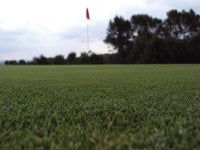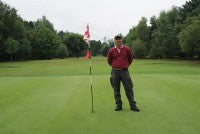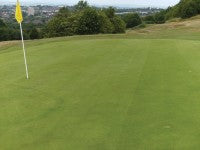Velvet underground
"The colour of the sward really started to show through early, it is a beautiful dark green. I would estimate that, in about five years time, my greens will be about 80% velvet bents"
Darryl Keen, Head Greenkeeper, Mapperley Golf Club
 In times of economic uncertainty and increasing environmental scrutiny, greenkeepers up and down the country are having to think a little more carefully about sustainable and cost effective solutions when purchasing their grass seed.
In times of economic uncertainty and increasing environmental scrutiny, greenkeepers up and down the country are having to think a little more carefully about sustainable and cost effective solutions when purchasing their grass seed.
With golfers playing 80% of their game on the greens (both with their clubs and their eyes), greenkeepers are more than aware that memberships can be lost, or saved, depending on their appearance, trueness, ball speed and resistance. Downtime and closed courses are just not an option nowadays.
It is not a surprise to learn that most UK golf greens consist largely of the dominant UK native meadow grass (Poa annua), which is costly and time consuming to maintain. It's susceptibility to disease and thatch is also a huge headache, which many greenkeepers have now accepted as 'part of the job'.
Now, with the rise in popularity of velvet bentgrass (Agrostis canina), greenkeepers have found a way to seed their greens and manage them with minimal maintenance, feeding and watering programmes.
To understand how velvet bents could offer a solution, let's first look at the problems.
Poa annua dominated greens can be time consuming and extremely costly to maintain. Precise attention to detail is required, and a true and smooth putting surface can all too often be a goal that is always 'just out of reach'. Meadow grass is extremely vulnerable to diseases and fungi, such as fusarium patch, dollar spot and anthracnose. Dry patches are also commonplace and can be caused by a whole host of bewildering problems, from less than adequate irrigation systems to fungus and the competing rootzones of thirsty trees in the nearby rough.
In many cases, greenkeepers believe that increased fertiliser and fungicide applications are the answer to halt and treat the symptoms - this, of course, is a common misconception.
 Andre Erlah, Course Manager at Easingwold Golf Club, knows this all too well. "When I arrived at Easingwold, the greens were pure meadow grass and completely thatch ridden, up to two inches thick in places. Almost all of the organic matter beneath the surface was dead. The previous greenkeeper was curing the symptoms and not the causes. Lack of aeration and increased applications of NPK fertiliser and fungicide (up to ten times a year) had destroyed the organic structure in the soil."
Andre Erlah, Course Manager at Easingwold Golf Club, knows this all too well. "When I arrived at Easingwold, the greens were pure meadow grass and completely thatch ridden, up to two inches thick in places. Almost all of the organic matter beneath the surface was dead. The previous greenkeeper was curing the symptoms and not the causes. Lack of aeration and increased applications of NPK fertiliser and fungicide (up to ten times a year) had destroyed the organic structure in the soil."
"I remember putting a spade in and lifting out a paving slab-like piece of the green with ease, this was because the roots were so shallow," recalled Andre. "Looking into it further, I could see that, beneath the rootzone, the ground was rock hard - it was in a really bad condition."
"My first reaction was to start aerating to get air into the soil and improve the rootzone. To my surprise, this actually killed off the organic matter completely, because the air activated trace metals in the soil, such as mercury and lead arsenic, that were left over from excessive fungicide use. My only option at this stage was to go 'cold turkey' for a while on my greens, after which I started to apply wetting agents to flush the old fungicide out of the soil."
 Andre's problems were severe, but not uncommon. In fact, reducing the amount of fertiliser and fungicide use was something high on Paul Underhill's list of priorities when he joined Dudley Golf Club. Paul takes up the story, "My greens were 100% meadow grass at one point and were consuming incredible amounts of fungicides and pesticides. I was also having a tough time with thatch problems, to the extent that, when the golfers walked on the greens in the wet, you could see deep footprints. Dudley Golf Club is a members club, registered as a Community Amateur Sports Club, meaning we don't have unlimited funds. Our water bills were becoming increasingly high, so we needed to act quickly to find a more sustainable option."
Andre's problems were severe, but not uncommon. In fact, reducing the amount of fertiliser and fungicide use was something high on Paul Underhill's list of priorities when he joined Dudley Golf Club. Paul takes up the story, "My greens were 100% meadow grass at one point and were consuming incredible amounts of fungicides and pesticides. I was also having a tough time with thatch problems, to the extent that, when the golfers walked on the greens in the wet, you could see deep footprints. Dudley Golf Club is a members club, registered as a Community Amateur Sports Club, meaning we don't have unlimited funds. Our water bills were becoming increasingly high, so we needed to act quickly to find a more sustainable option."
So, amongst the list of problems stacking up against their greens, including disease and fungus susceptibility, drought intolerance and thatch vulnerability, the greenkeepers began to look at a real, long term solution that could save them time and money in the future.
Eventually, their attention turned to velvet bentgrass as a real possibility to solve the problems on their greens. "I had been doing some in depth research into velvets for quite some time," explains likeminded head greenkeeper Darryl Keen at Mapperley Golf Club. "I decided that I wanted something that could outcompete the meadow grass on my greens - which I knew wouldn't be an easy task."
Darr yl called in Paul Moreton of British Seed Houses for a consultation, "Paul confirmed what I had already learned about the velvet bents, and recommended I gave the company's Level Par mixture a try. In particular, Paul told me how aggressive it was against Poa, its disease resistance, low water and nutrient requirements and high wear tolerance during extensive periods of use."
yl called in Paul Moreton of British Seed Houses for a consultation, "Paul confirmed what I had already learned about the velvet bents, and recommended I gave the company's Level Par mixture a try. In particular, Paul told me how aggressive it was against Poa, its disease resistance, low water and nutrient requirements and high wear tolerance during extensive periods of use."
Level Par is a mixture of two different breeds of velvet bents. British Seed Houses first introduced their pioneering Avalon velvet bentgrass to the UK golf market in the mid 1990s. Then, in 2005, they unveiled another velvet bentgrass called Vesper that had a slightly greater shoot density and finer leaf than its predecessor. In 2006, realising that many greenkeepers would prefer sowing a mixed culture as opposed to a mono culture, the company blended 50% Avalon and 50% Vesper together and named it Level Par.
Darryl first overseeded with Level Par in Autumn 2009 and reported an incredibly quick take. He noted that the sward was very thick, strong and dense allowing him to cut as low as 4mm. "The colour of the sward really started to show through early, it is a beautiful dark green. I would estimate that, in about five years time, my greens will be about 80% velvet bents."
 Grant Lee, Course Manager at Norwood Golf Club concurred with Darryl's results, "I seeded with velvet bents in April this year, and even though we still had some frosty mornings at that time of year, it still established very quickly. I've only seeded once with velvets since April, and already my greens have thickened up quite considerably and are changing to a very deep, dark green colour. My plan is to start seeding twice a year with Level Par across all of my 27 greens. I am at about 10% bents at the moment."
Grant Lee, Course Manager at Norwood Golf Club concurred with Darryl's results, "I seeded with velvet bents in April this year, and even though we still had some frosty mornings at that time of year, it still established very quickly. I've only seeded once with velvets since April, and already my greens have thickened up quite considerably and are changing to a very deep, dark green colour. My plan is to start seeding twice a year with Level Par across all of my 27 greens. I am at about 10% bents at the moment."
First overseeding with velvet bents in 2005, Andre Erlah at Easingwold Golf Club was the first of the four greenkeepers to use it. Five years down the line, what are his results? "In the first year I noticed the velvets at about 10% - 25% on my greens. In 2010 I can tell you that the majority of my greens are up to 80% velvet bents."
The economical value of using Level Par is rapidly becoming apparent at Norwood Golf Club as well, Grant is now sowing just 40-60kg of Level Bents on all of his 27 greens, as opposed to 70-80kg of his old seed.
Andre also confirmed the need for less feed on his greens, "I literally halved the amount of fertiliser and fungicide usage from what was used before we started seeding with velvets - they are incredibly disease resistant, they just don't need it. My treasurer is definitely a lot happier because he is noticing that the bills are less since making the change."
 Paul Underhill at Dudley Golf Course also noticed a big difference in his fungicide application since using Avalon, "I have got four litres of fungicide in my chemical locker left over from the last greenkeeper, I think it's out of date now!"
Paul Underhill at Dudley Golf Course also noticed a big difference in his fungicide application since using Avalon, "I have got four litres of fungicide in my chemical locker left over from the last greenkeeper, I think it's out of date now!"
So, with BSH converting over forty golf courses in the UK alone, what are the downsides of velvet bentgrass, if there are any? Is it possible that using velvets on your greens is simply a case of 'survival of the fittest'? If so, then why are so many greenkeepers still hesitant to make the change?
"That's the six million dollar question," joked Andre Erlah. "In my opinion, it's a natural progression to start seeding your greens with velvets. To put it simply, they WILL make your life easier as a greenkeeper - velvets have certainly taken a lot of worry out of my job." Darryl Keen compounded Andre's thoughts, "I think that some people are a little dubious about switching to velvet bents because they are a native grass of Scandinavia and not the UK. I've actually heard that they are from Scotland, but who cares where they originate, if your greens are looking great, then that's all that matters."
Grant Lee believes that some greenkeepers may be slightly wary about the aggressiveness of the velvets, "This can cause a build up of thatch in places. However, with a good aeration and basic maintenance programme, you can keep it well in check."
Richard Brown, Amenity Sales Manager at British Seed Houses is absolutely positive that a change to velvet bents is an intelligent choice, he explained: "Many greenkeepers are nervous of making changes to the species composition of their greens due to pressure from the members and green committee. This is based on perceived changes that may be seen in the playing surface and interruption of the playing calendar."
"What we're saying is that, rather than continue with what you've always done (i.e. continue to sustain predominantly Poa annua based greens), aim to establish velvet bent that will ultimately require far less nutrients and water, exactly the thing that keeps the Poa annua going. The idea is to make a gradual change to a leaner nutritional regime and starve the Poa annua out."
 The environmental advantages of using velvet bentgrass cannot be underestimated, even when compared against other bentgrasses. This was confirmed in 2005 when the study, 'Minimum Water Requirements for Creeping, Colonial and Velvet Bentgrasses under fairway conditions' was published online by Michelle DaCosta and Bingru Huang.
The environmental advantages of using velvet bentgrass cannot be underestimated, even when compared against other bentgrasses. This was confirmed in 2005 when the study, 'Minimum Water Requirements for Creeping, Colonial and Velvet Bentgrasses under fairway conditions' was published online by Michelle DaCosta and Bingru Huang.
This trial set out to determine and compare minimum water requirements for maintaining acceptable quality fairways established with colonial, creeping and velvet bentgrasses.
Plots of each bentgrass species were irrigated to replace 100%, 80%, 60% and 40% ET (Evapotranspiration: water usage) with results recorded in winter and summer.
Results were measured by recording and comparing soil moisture content, turf quality and plant chlorophyll levels/colour (a common indicator of plant health) in all cases.
Velvet bentgrass plots retained higher soil moisture content than both creeping and colonial bentgrasses under all deficit regimes.
This characteristic of soil moisture retention will be particularly well suited to the predicted UK weather patterns in the near future. The Met Office confirmed that, whilst annual rainfall is not expected to change in the UK, it will increasingly come in deluges followed by long dry periods.
Certain geographical features of a golf course, that at first would seem a disadvantage, can act in favour of the velvet bents, Joe Hendy of BSH explained, "some of the greens at Dudley Golf Course are noticeably higher than others because of the hilly layout of the course. The drought tolerance and low maintenance characteristics of the velvet bents means that they are now noticeably dominating and thriving at the top of the hills due to the nutrients and water draining away, the absolute opposite of what is happening to the Poa."
With environmental activist groups in the USA going as far as vandalising facilities that research grass breeds for golf courses, the 'green' situation is at boiling point. What do our greenkeepers think about the effect that velvet bents will have upon the negative environmental image that golf courses currently have?
"Golf courses get slated for the amount of water and fertilisers they use, don't they?" comments Darryl Keen. "The velvets definitely require less water and fertiliser, as far as the environment is concerned, that is fantastic. Meadow grass absolutely loves loads of water and fertiliser."
Grant Lee has already noticed a reduction in fertiliser use on his greens since seeding with velvets, "I only seeded with BSH Level Par for the first time in April this year, and I am already using less feed. This is definitely good news for the course, environmentally."
So, what do the members and players think, as that is ultimately the true 'acid test'?
"Well, put it this way, this is the first year that we haven't had any complaints about the greens," reflected Paul Underhill. "The members are over the moon with the results, they have been telling me that the greens are truer and the ball is running smoothly. The word must be getting around as we are getting a lot more visitors to the club and enjoying the course now."
Andre Erlah is also reaping the benefits of using velvet bents at Easingwold Golf Club. "Before using the velvet bents, the greens were unplayable in the winter, because of their condition. Now, the greens are playable in the winter, allowing us to be open for the members a lot more."
In conclusion, velvet bents seem to offer a real all round solution to an outdated meadow grass green. Can we go as far as to say that velvet bents are the natural solution to the host of problems that Poa annua creates? In the simplest of terms, velvet bents require far less nutrients and water - exactly the thing that keeps the Poa annua, and the problems that it causes, alive.
